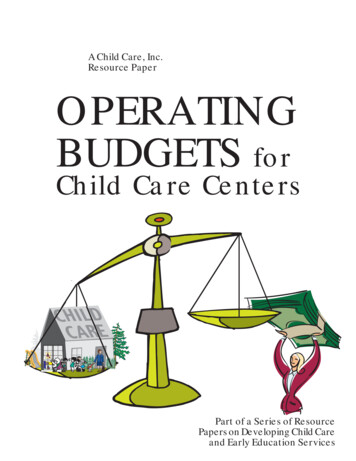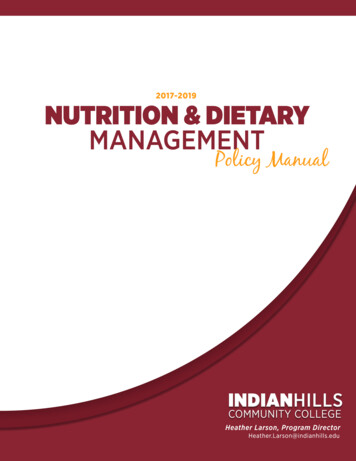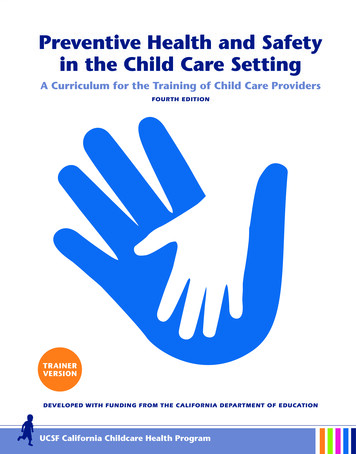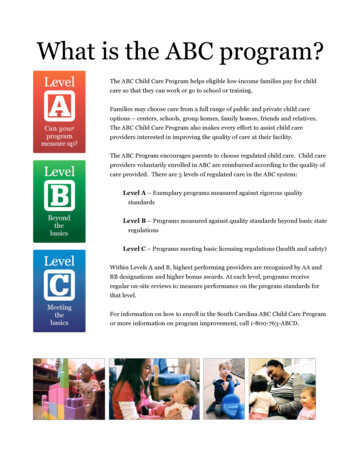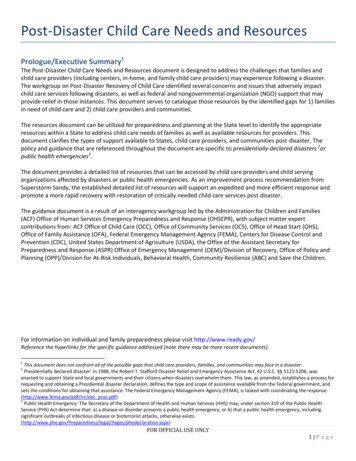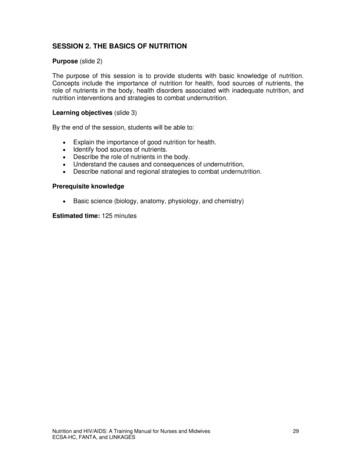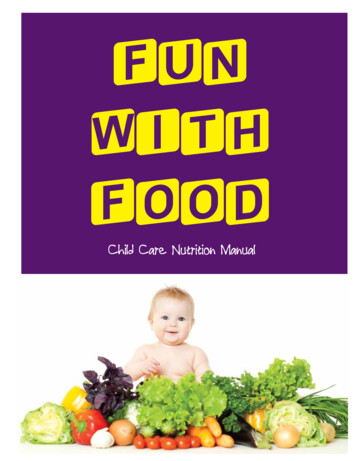
Transcription
Child Care Nutrition Manual1
This resource is reproduced with permission of Simcoe Muskoka District Health Unit. Sample Menus on pages 27-31and information on page 17 adapted with permission from KFL&A Public Health. Menu Planning Checklist onpage 11 and 32 adapted from ‘Menu Assessment Checklist’ with permission of the Eastern Ontario Health Unit.2965 JD Fun With Food Oct 2016
Table of ContentsIntroduction.1Nutrition Requirements of the Child Care and Early Years Act.2Nutrition for Healthy Term Infants (6-24 Months).3Eating Well With Canada’s Food Guide (For Ages 2 And Older).4Feeding Meals And Snacks To Children In Child Care Centres.5A Healthy Mealtime Environment.6Menu Planning in Child Care Centres.8Beverages. 14Meal & Snack Ideas. 15Vegetarian Meals. 17Tips For Adding More Variety. 18Tips For Grocery Shopping. 19Choking Hazards. 24Special Dietary Requirements. 25Appendix 1: Sample Menu Template. 27Appendix 2: Sample Menu. 28Appendix 3: Nuts Allowed Sample Menu. 29Appendix 4: Peanut Free Sample Menu. 30Appendix 5: Vegetarian Sample Menu.31Appendix 6: Menu Planning Checklist. 32
IntroductionYour influence as a child care provider is very important. Children spend a large part of their day inyour care. Children in attendance for more than six hours receive at least half of their daily nutritionfrom you! You have the opportunity to shapechildren’s eating habits to be as healthy as possible.You can do this by role modeling healthy eatinghabits, having a healthy attitude towards food, andproviding healthy meals and snacks.This nutrition manual is meant to help you meetthe nutrition requirements of the Ontario Child Careand Early Years Act, 2014 Regulation 137/15, andhelp you plan nutritious menus that will provideimportant vitamins, minerals and energy forgrowing children at your child care facility.The Importance of Healthy Eating For Infants and PreschoolersFood is more than just something to eat! Food is important for children because: Children grow and develop more rapidly during the first three years than at any other timeof life. As children learn to feed themselves, they are developing motor skills. Eating food provides learning opportunities. Where does food come from? How is it made? Variety is the spice of life! Young children are curious and want to try new foods. Studiesshow that children who have experienced a variety of food tastes, textures and colourswhen they are young are better eaters and are better nourished. Mealtimes provide a good opportunity for children and staff to communicate in a familystyle setting, and provide pleasure and satisfaction for children in a relaxed atmosphere.Children acquire attitudes towards food from their caregivers. Good eating habits learned in the early years can last a lifetime.1
Nutrition Requirements of the Child Care andEarly Years ActRegulation 137/15, specifically sections 42-44, of the Child Care and Early Years Act (CCEYA ) isintended to ensure all children attending home and licensed child care centres receive foodsthat are safe and nutritious, and meet current nutrition recommendations for infants, toddlers,preschoolers and older children.All meals, snacks and drinks served by child care providers must meet the recommendations ofEating Well with Canada’s Food Guide (or Eating Well with Canada’s Food Guide – First Nations,Inuit and Métis) or Nutrition for Healthy Term Infants.According to the CCEYA, child care providers should ensure that: Parents are providing written feeding instructions for all children less than one year of age. Parents are providing written instructions for all children with special dietary needs. Food or drink provided by parents must be clearly labeled with the child’s name and thedate the food was sent to the centre. Food or drink is stored in a manner that maximizes their nutritive value and minimizes therisk of contamination or spoilage. A list of children with food allergies or restrictions and the specifics of the allergy orrestriction is posted in clear view in: Each cooking and serving area Eeach play area or play room In any other area where children may be present. Complete menus are posted in an obvious and visible location for the current and followingweek. Any substitutions must be written on the posted menu. Menus are kept for 30 days following the last day that it was applicable.2
Nutrition for Healthy Term Infants:Six - 24 MonthsThe following nutrition recommendations are intended for children six - 24 months old: Support breastfeeding for up to two years or longer with appropriate complementaryfeedings. Introduce iron-rich meat, meat alternatives and iron-fortified cereal as the firstcomplementary foods. Progress to introduce a variety of other nutritious foods. Offer a variety of textures from six months of age (e.g., lumpy, mashed, ground, minced,pureed). Offer finger foods to encourage self-feeding. Younger children should be fed on demand, based on their hunger and fullness cues. Fromone year of age, children should begin to follow a regular schedule of meals and snacks. Encourage children to use an open cup. Wait to introduce homogenized cow’s milk until children are at least nine -12 months oldand eating a variety of iron-rich foods. Do not serve honey (cooked and uncooked) to children under one year of age. Always supervise children when eating and drinking. Children should be sitting uprightand free from distraction.To learn more about Nutrition for Healthy Term Infants, visit: isson/index-eng.php3
Eating Well with Canada’s Food Guide:2 Years and OlderEating Well with Canada’s Food Guide applies to children ages two years and older. The guide givesrecommendations for the amount and types of food required each day. It has been developed tohelp Canadians meet their nutrient requirements at every stage of life.It is important to recognize that every child is an individual and the amount of food they require tomeet their energy and nutrient needs will vary. In general, younger children require smaller servingsizes than older children. It’s better to offer smaller portions initially and provide more food if thechild is still hungry.What is a Food Guide Serving?Canada’s Food Guide has 4 food groups: Vegetables and Fruit, Grain Products, Meat andAlternatives, and Milk and Alternatives. A food guide serving is a reference amount. It helps youunderstand how much food is recommended from each of the four food groups every day. Thefollowing are examples of food guide servings according to Eating Well with Canada’s Food Guide.Vegetables and Fruit 125mL (½ cup) fresh, frozen or canned vegetable or fruit 250 mL (1 cup) leafy raw vegetables or salad 1 piece of fruitGrain Products 1 slice (35 g) bread or ½ bagel (45 g)½ pita (35 g) or ½ tortilla (35 g)125 mL (½ cup) cooked rice, pasta, or couscous30 g cold cereal or 175 mL (¾ cup) hot cerealMilk and Alternatives 250 mL (1 cup) milk or fortified soy beverage 175 g (¾ cup) yogurt 50 g (1 ½ oz.) cheeseMeat and Alternatives 75 g (2 ½ oz.)/125 mL (½ cup) cooked fish, shellfish, poultry or lean meat175 mL (¾ cup) cooked beans2 eggs30 mL (2 Tbsp) nut butterFor more information on Eating Well with Canada’s Food Guide, visit: dex-eng.php4
Feeding Meals and Snacks To ChildrenIn Child Care CentresThe nutrition section of the CCEYA does not list the specific amounts of food that must be providedwith each meal and snack. All foods given to children at child care centres should be foods fromthe four food groups in Eating Well with Canada’s Food Guide. Basing meals and snacks on the FoodGuide will provide plenty of vitamins, minerals and other nutrients that contribute to the nutritionalneeds and well-being of growing children. Use the following as a guideline for meals and snacks:How Much in a Meal?*Meals should include a variety of foods from all four food groups with two different types ofvegetables or fruit offered. Each meal should include: 2 different vegetables or fruit 1 grain product 1 milk and alternative 1 meat and alternativeIf a child is present at the child care centre or home over meal time, a meal must be served. Childrenwho are present for more than six hours must be offered two snacks in addition to meals.How Much in a Snack?*Snacks should include foods from at least two of the four food groups. If more than one snack isoffered per day, switch up the food groups offered in each snack. Include foods from the Vegetableand Fruit food group in at least one snack each day. Serve snacks at least two hours before meals.* Children between the ages of one and two years can also follow these recommendations.Drinking water must be available at all times.A Note about Child-Sized ServingsAs a child care provider, you should offer food in child-size servings at the main meal and snacks.Offering small servings will allow children to feel like they can manage their food, making themmore likely to eat it.Child-sized servings are anywhere from one-half to the full size of the servings described in Canada’sFood Guide on page 4. Servings can be divided into smaller amounts and served throughout theday. For example, one half of a vegetable or fruit serving may be served at two different snacks toadd up to one full serving. Serving size usually increases with the age of the child.Offer child-size servings and have extra servings available. Let the child decide if they are stillhungry, and ask for more if they want more. Sometimes children will eat a little, sometimes a lot. Thisis normal. Children know best how much they need to eat. Different children need different amountsof food depending on things like age, body size, activity level, growth rate and appetite.5
A Healthy Mealtime EnvironmentCaregivers and children have different “jobs” at meal time. Struggles happen when one tries to dothe other one’s “job”. How a child is fed is as important as what a child is fed.Caregiver jobs:Child’s jobs: WHAT to eat – Choosing what foods areoffered. A child can have input but thecaregiver sets limits and avoids being ashort-order cook. HOW MUCH – Children know howmuch to eat when they are allowedto listen to their internal cues ofhunger and fullness. WHEN to eat – Having a schedule ofregular meals and snacks, three meals withsnacks in between spread over the day. WHETHER to eat – Children willeat. What they eat over time, andnot at a given meal or snack, is mostimportant. WHERE to eat – Making mealtimepleasant, eating together as a group atthe table, removing distractions (e.g., toys,books).It is not a caregiver’s job to “get a child to eat”. It is normal for children to be very hungry some daysand not hungry on other days. It is ok for a child to skip a meal or snack once in a while.Caregivers can: Offer meals and snacks at consistent timeseach day so a child knows she can count onher next eating time. Offer a variety of healthy foods at each mealand snack, trying different tastes, texturesand food combinations. Offer children choice from the foodsprepared, but avoid cooking somethingdifferent because the child demands it.Inform the child that what is served is theonly option. Never force a child to eat or punish them fornot eating. This creates negatives feelingsassociated with food. Offer new foods with a neutral approach.Children may need to see a new food10-15 times before they will accept it. Avoid using food as a reward, punishment,or bribe.6 Know that a child will not starvethemselves. They may miss mealsand snacks, but they will not do itfor long enough to cause severemalnutrition. Understand that feeding challengeswill only get better when a childknows that their caregiver will nottry to control how much or whetherthey eat. Make meal and snack timespleasant by minimizing distractionssuch as the screens, toys or books. Make sure children have enoughtime to eat. Allow 20-30 minutes formeals and 15 minutes for snacks. Involve children in growing,preparing and cooking food, andclean-up when possible.
Children who are pressured to eat often eat less. Respect their internal hunger and fullness cues byavoiding these types of comments: “Just take one more bite.” “No dessert until you eat your meat.” “Good boy. You ate all your peas.” “No more bread until you eat some vegetables.” “Finish your milk. It’s good for you.”7
Menu Planning In Child Care CentresMenu Planning StepsUse a “menu planning template” to record the week’s menus. A sample template is included onpage 27 for you to copy and/or laminate. You can re-use the form with a water soluble marker eachtime you make changes to an existing menu or plan a new menu.Follow These Nine Steps for Easy Menu Planning:1. Select the meat or alternative for each day of the week (main meal) Choose a different meat or alternative for each day: beef, pork, fish, poultry, baked beans,peas, lentils, eggs, peanut butter (if allowed). Consider serving fish twice a week. Choose lean meat and alternatives prepared with little or no added fat or salt. Serve meat alternatives (e.g., tofu, chickpeas, lentils, beans, etc.) at least once a week.2. Select a vegetable for each day of the week (main meal) Provide at least one dark green (e.g., broccoli, green peas or beans, spinach, romaine lettuce)and one orange vegetable each day (e.g., carrots, sweet potato, squash). Choose vegetables prepared with little or no added fat, sugar or salt. Include a variety of cooked and raw vegetables throughout the week. Use different textures and shapes, such as grated, chopped, mashed, sliced, cubed, sticks,wedges. Serve a variety of vegetables in many colours.3. Select one more vegetable or fruit for each day of the week (main meal) Serve fruit prepared with little or no added fat, sugar or salt. Choose whole fruit more often than fruit juice. Fruit juice should be limited to 125 mL (1/2 cup) per day. Avoid fruit ‘punches’, ‘drinks’,‘beverages’, pops, and sports and energy drinks. Choose only 100% fruit juice. Frozen and canned vegetables and fruit are healthy and budget friendly options. Chooseunsweetened frozen fruit and fruit packed in water or juice instead of syrup. Choose lowsodium canned vegetables, and drain and rinse canned vegetables before using them. When possible, serve vegetables and fruit that are in-season and grown locally. If your facilityhas freezer space, buy extra seasonal produce and freeze for later use.8
4. Select a grain product for each day of the week (main meal) Serve whole grain products most of the time. Examples include whole grain breads, wholegrain pastas, and brown rice. Include a variety of grain products such as pasta, rice, barley, couscous, bagels, pitas, tortillas,rye bread, oatmeal, and quinoa. Choose grain products that are lower in fat, sugar and salt, and higher in fibre.5. Select milk or a milk product for each day of the week (main meal) Serve 1% or 2% milk each day for children age two and over. Serve breastmilk or whole milk(3.25%) for children under two years. Serve milk at lunch and at least one snack. Serve milk products, like yogurt, milk pudding, and cheese for snacks or desserts. Include milk products as ingredients in soups and smoothies.6. Plan morning and afternoon snacks to complement meals Select snacks from the four food groups of Eating Well with Canada’s Food Guide. Offer food from at least two food groups at each snack. Include foods from the Vegetable andFruit food group in at least one snack each day. Choose snacks that are low in added sugar and do not stick to teeth. Keep portion sizes small. Serve snacks about two hours before the next meal.7. If you offer a dessert, choose it from one of the four food groups It is not necessary to plan desserts such as cake or cookies. Some nutritious dessert ideas are homemade fruit crisp, fresh fruit, yogurt, milk pudding,fruit canned in juice, and homemade oatmeal cookies.8. Include some healthy fats and oilsChildren need some healthy fats to help them grow. Some examples of healthy fats and oils are: Vegetable oil (e.g., canola, olive, soy) Soft margarines made from non-hydrogenated oil Mayonnaise Salad dressings AvocadoLimit or avoid using these unhealthy fats: Hard margarine Lard Shortening Butter9
9. Double check your menuUse the Menu Planning Checklist to ensure your menu meets or exceeds Canada’s Food Guiderecommendations.For menu, recipe and meal ideas, see Appendix 2-5, or: visit -eating10
Menu Planning ChecklistThe checklist below will help ensure your menu meets or exceeds Canada’s Food Guide recommendations.Child Care Setting:Add a checkmark in the box for each requirement that is met.Date:1. Whole grain choices are served most of the time (barley, brown rice, oats, quinoa, couscous, pasta, tortilla, pitas, crackers, bread and oatmeal).2. Dark green vegetables (broccoli, romaine lettuce, asparagus, spinach) and orange vegetables or fruits (carrots, sweet potatoes, wintersquash, pumpkin, apricots, cantaloupe, canned peaches, nectarines and mangoes) are served most of the time.3. Meat alternatives such as beans, eggs, soybeans, lentils and tofu (egg sandwich, baked beans, hummus/bean dips, pea soup,vegetarian chili) are served at least once a week.4. Milk is served at meals and at least 1 snack (serve whole milk, 3.25% for children 1-2 years).5. Fish is served twice a week (salmon loaf, tuna casserole, tuna croquettes, fish burgers, fish fillets).6. Foods high in calories, fat, sugar and salt (sodium) such as cakes, pastries, cookies and ice cream are limited (deep fried foods and hotdogs are not recommended).7. The menu includes foods with different: colours and flavours shapes (shredded, in strips, cubes, slices of different sizes) temperatures and textures (cooked, raw, crispy, crunchy, chewy, smooth consistencies)8. The menu includes: Foods that are easy to eat and suited to the children’s personal and cultural preferences Some finger foods Child-size servings9. The menu includes food choices that are safe to eat: Foods that can cause choking such as peanuts, nuts, seeds, dried fruit, whole grapes, raw vegetables andchunky peanut butter are excluded from the menu, for children under the age of 4. Popcorn and hard candies are excluded from the menu.10. The menu excludes sticky, sweet foods such as dried fruit and candy, which can stick to the teeth and cause cavities (unless childrenbrush their teeth right after or dried fruit is served with a piece of hard cheese).11. Safe drinking water is available at all times12. The menu limits juice to one serving per day (125 to 175 mL). Juice is 100% unsweetened fruit juice.MAIN MEAL (LUNCH)The main meal (lunch) includes at least TWO different Vegetables or Fruit (VF), ONE Grain Product (GP),ONE Milk and Alternative (MILK) and ONE Meat and Alternative (MA) (check all that apply):MEALSSUNMONVFWEEK AMAMAVFWEEK 4VFTHURSGPVFWEEK 3WEDGPVFWEEK KMILKMILKMAMAMAMAMAMAMA11
MORNING SNACK (BREAKFAST)The morning snack (breakfast) includes foods from at leastTWO different food groups (check only those that apply):MEALSWEEK 1WEEK 2WEEK 3WEEK AMAMAAFTERNOON SNACKThe afternoon snack includes foods from at leastTWO different food groups (check only those that apply):MEALSWEEK 1WEEK 2WEEK 3WEEK AMAMAAdapted from ‘Menu Assessment Checklist’ with permission of the Eastern Ontario Health Unit.12
Additional Menu Planning Guidelines Use at least a three or four week menu cycle. Plan extra meals and snacks for children who spend more than six hours in your care. Ensure adequate equipment, staff and time are available to prepare meals and snacks. Keep meals and snacks fairly simple; children prefer them that way. Introduce at least one new food during the menu cycle. Serve them with foods that are wellliked. Encourage children to try them; do not force them to do so. Try not to let your personal food preferences restrict menu choices. Children may enjoy foodsyou dislike. Allow children 20-30 minutes to enjoy meals and 15 minutes for snacks. Provide snacks and meals in a designated area where children can sit and eat withoutdistraction. Have at least one adult or staff member sit and eat with the children at snack and meal time. Have the children serve themselves with appropriate serving utensils. Offer second helpingsfor those who want more. Allow about two hours between the end of snack time and the beginning of meal time. Decide what, when and where food is served. Allow the child to decide how much to eat andwhether to eat. Role model healthy eating habits by eating in accordance with Canada’s Food Guide.Remember that children pick up on comments, gestures and attitudes toward food. Have children learn about healthy eating daily. Involve children in snack and meal preparation when possible. Allow families the opportunity to provide input with menu planning. Encourage the continuation of breastfeeding whenever possible. Remove any references to infant formula companies and/or fast food companies. Serve healthy food and drink choices at all special events. Do not use food (nutritious or otherwise) as a reward or punishment. Allow for substitutions for children with allergies and special diets or encourage parents tosupply their own substitutes. Grow some of your own vegetables on site. Involve children in selecting, planting and caringfor a variety of vegetables and fruits. Carrots, beans, tomatoes, cucumbers, squash andpumpkins grow well and are likely to be enjoyed by children. Purchase locally grown or raised foods when available. Celebrate different cultures by introducing varied food choices that represent the ethnicdiversity of your child care centre. Involve parents in helping you identify appropriatechoices.13
BeveragesMilkFrom the time milk is introduced (nine -12 months) to two years of age, serve homogenized (3.25%)cow’s milk. After two years, 1% or 2% cow’s milk can be served. Fortified soy milk is not appropriatefor children younger than two years, but may be offered after two years. Other plant-based milks(e.g., rice, almond, etc.) do not have enough nutrients for growing children.A child needs two cups (500 mL) of milk per day andnot more than three cups (750 mL). If a child fills upon milk, he won’t be hungry for other healthy foodshe needs. Offer milk at meal and snack times only.WaterWhile milk can be served with meals and snacks, safewater should be readily available for children to drinkthroughout the day. Hydration is important to keeporgans working well and may help prevent childrenfrom becoming irritable.JuiceFruit juice is not necessary for a child whose dietincludes fresh fruit. Too much fruit juice can interferewith good nutrition by replacing other nutritiousfoods and decreasing a child’s appetite for meals and snacks. Too much juice can also cause chronicdiarrhea, flatulence, bloating, abdominal pain, poor weight gain and early childhood tooth decay.If juice is included in the menu, the amount should not exceed 125 mL per day. Be sure to serveonly 100% juice. Offer it as part of a meal or snack only and in a cup, not a bottle.Although diluting fruit juice with water is a common practice, it is important to note that dilutedfruit juice can still decrease a child’s appetite, interfere with good nutrition, and cause earlychildhood tooth decay.14
Meal and Snack IdeasMeal Ideas: Sample Combination DishesCombination dishes should be comprised mainly of foods from the four food groups. Below aresome examples of common combination dishes that include foods mainly from the four foodgroups in Eating Well with Canada’s Food Guide.Chililean ground beef, kidney beans, vegetablesPizzawhole-wheat crust, lower-fat cheese, vegetables, pineappleHamburgerslean ground beef for patties, whole-wheat buns, vegetables for toppingsLasagnalean ground beef, partly-skimmed mozzarella cheese, variety ofvegetables (e.g. mushrooms, broccoli, peppers)Soupstry any combination of foods in any of the four food groups(e.g. pasta, rice, barley, vegetables, beans/peas/lentils)Macaroni & Cheesewhole wheat pasta, combination of lower and higher fat cheeses, milkSubmarine Sandwicheswhole wheat submarine buns, vegetables (e.g. tomatoes, peppers, darkgreen lettuce) lean meats (e.g. turkey, roast beef, ham)Vegetable/Meat Stir-Fry boneless and skinless chicken (or other lean meat), fresh or frozenvegetables, rice or noodles15
Snack Ideas:Snacks contribute significantly to a child’s overall energy and nutrient intake. So, it is important thatsnacks provide plenty of vitamins, minerals and other nutrients that contribute to the nutritionalneeds of growing children. Plan snacks that contain foods from at least two of the four food groups.For variety, change up the food groups and the foods that make up the snack during the day andthroughout the week. Include foods from the Vegetables and Fruit food group in at least one snackeach day.Here are some snacking ideas. The appropriate food group is listed in brackets beside each snack toassist you when planning the menu.VF Vegetables and FruitMP Milk and AlternativesG Grain ProductMA Meat and Alternatives 16Baby carrots and yogurt dip (VF, MP).Grapes and rice crackers (VF, G).Banana sandwich (VF, G).Yogurt and fruit (MP, VF).Apples and cheese (VF, MP).Cheese and crackers (MP, G).Rice, cakes and nut butter (G, MA).Unsweetened cereal and milk or yogurt (G, MP).Apple, cored, and filled with nut butter (VF, MA).Vegetable sticks (try broccoli, carrots, cauliflower, peppers, mushrooms, cherry tomatoes,cucumber, and celery) and yogurt dip (VF, MP).Smoothie (yogurt fruit milk) (MP, VF).Tofu smoothie (silken tofu banana fruit) (MA, VF).Bell peppers and hummus (G, MA).Oatmeal muffin and milk (G, MP).Cheese cubes with apple slices and grapes (MP, VF).Bagel with nut butter (G, MA).Pineapple rings/ peach slices with cottage cheese (VF, MP).Fruit juice popsicle and yogurt (VF, MP).Yogurt drink and muffin (try carrot, oatmeal, or bran) (MP, G).Celery filled with nut butter (VF, MA).Whole-wheat tortilla or pita triangles with hummus (G, MA).½ sandwich (try cheese, lea
This nutrition manual is meant to help you meet the nutrition requirements of the Ontario Child Care and Early Years Act, 2014 Regulation 137/15, and help you plan nutritious menus that will provide important vitamins, minerals and energy for growing children at your child care facility. The



